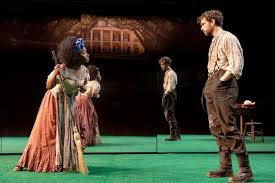Theater Review: An uneven The Slave Play plumbs raw interracial sexual emotion
The Slave Play
By Jeremy O. Harris
Directed by Robert O’Hara
New York Theater Workshop, Manhattan
January 6, 2019
This new play about race relations relies on shock effect to
make its main point. Spoiler: I will now divulge the shock, which is the main
thing to talk about here. The play opens with three lurid sexual couplings,
each a mixed-race couple in the antebellum South. A “big house” lady rapes a
dignified articulate handsome black butler. A white male share cropper is
seduced by black male over-slave. And a randy white overseer rapes a beautiful
black woman slave. This extended prelude is done with lurid lighting, (mostly)
convincing southern accents, and partial nudity. And a dildo. At the end of
this orgy (oddly ended by one guy calling out “Starbucks”) all the characters
are summoned to the “big house”, where part two of the play commences.
The play ultimately left only a moderate impression on me.
The opening sexuality was intended to shock the audience into awareness
(“woke-ness”) that would make us receptive to the talky therapy that followed,
and make us see the link between white-black repression then and now. But I
thought the opening antebellum scenes were just a bit too familiar from past
movies (Mandingo, Django Unchained)
to really shock, and the talk therapy seemed too familiar from similar
therapy-on-stage dramas. The set of the group therapy session featured a now-cliché device of mirrors behind
the players, forcing the audience to see itself in the drama. This device was
stunning the first time I saw it at the Bayreuth Wagner festival at the end of Parsifal in 2010 (the large mirror was
rolled out for dramatic effect at the end of the opera). But here, having it
onstage for the whole play seemed a bit much. The acting was largely convincing
but went over the top into melodrama at times. The best actor was Teyonah
Parris (If Beale Street Could Talk)
as the angry black slave and resentful partner of an emotionally repressed
British white man. By the way, he was the one who called out the trigger word
“Starbucks” to prematurely end the antebellum role play, causing his wife to
resent him deeply for controlling the experience and from preventing her from
fully experiencing the exercise’s full impact. Ms. Parris demonstrated wide
emotional range, initially reluctant to share anything with the group, but
finally displaying the rawest, most genuine feelings. Hers was the one moment
when I felt the anger of the modern black person most acutely.
I think this play was an interesting, if slightly gimmicky
inspiration for conveying the emotions of a complex modern social problem in a
novel way. It was very refreshing to see a playwright willing to shock us
rather than creating a “safe space”. Unfortunately the execution of the
inspiration was middling, both in dialogue and production.

Comments
Post a Comment